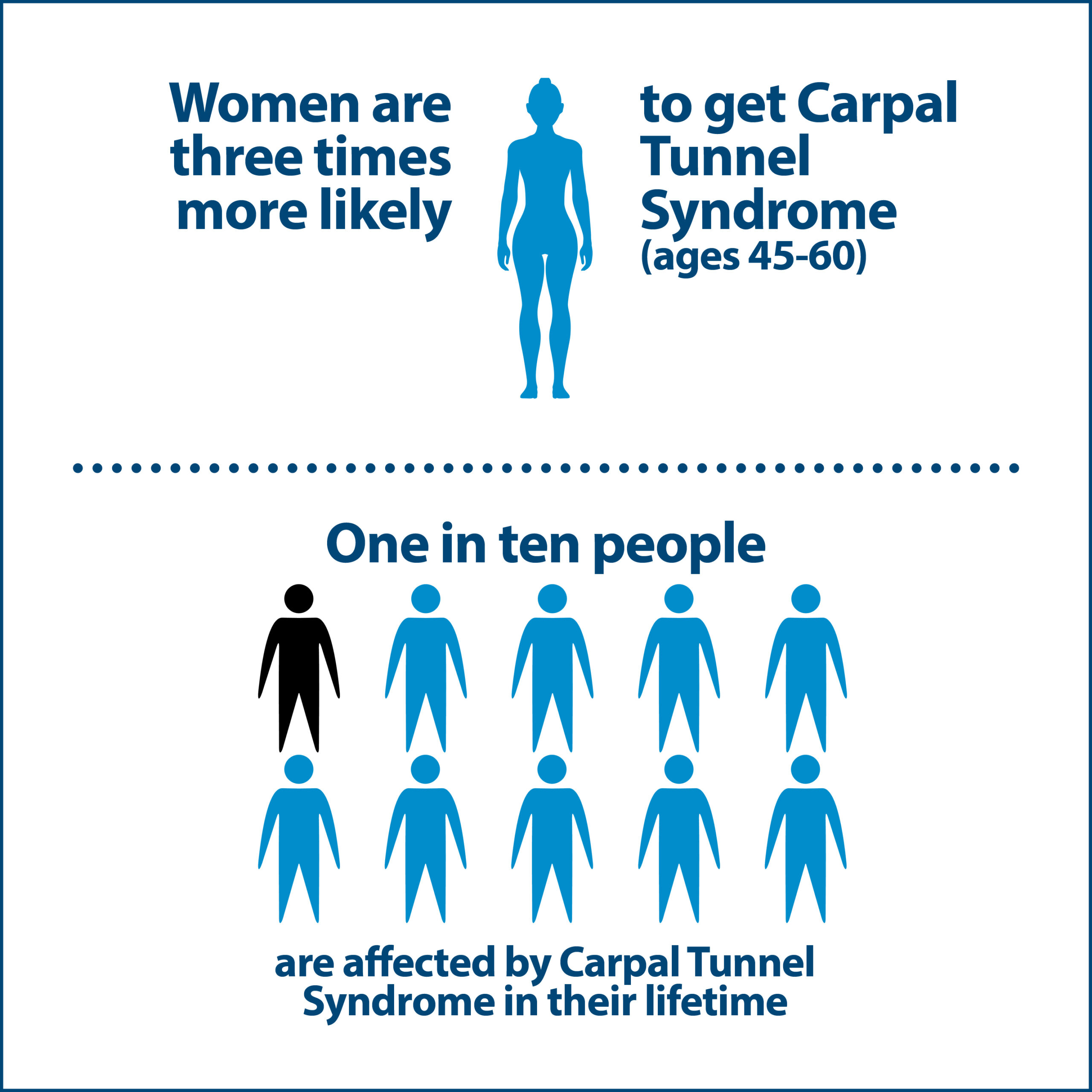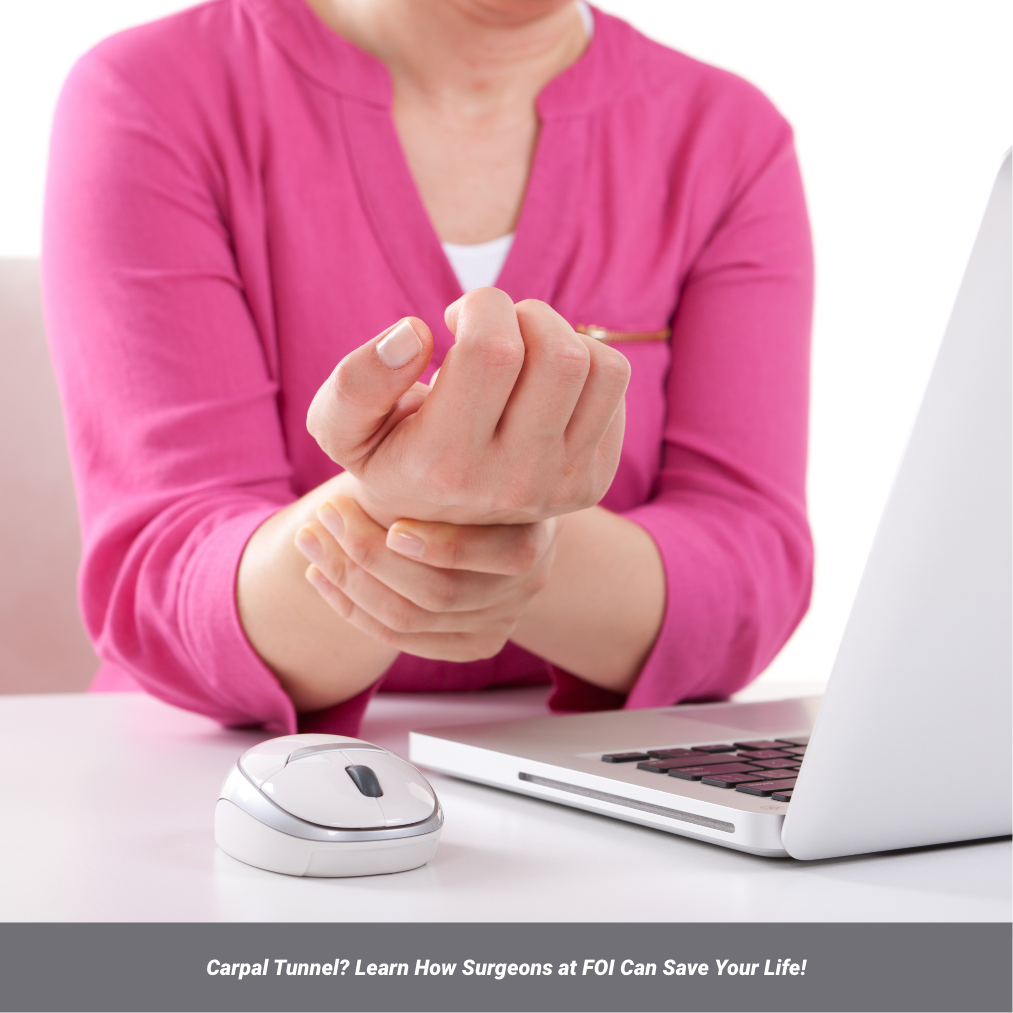Carpal Tunnel Syndrome
Carpal tunnel syndrome results from placing stressful weight on the wrist’s median nerve. The forearm’s tendons, along with the median nerve, pass through to the hand through a very small space called the carpal tunnel. Since the median nerve controls finger movement, undue weighted pressure on this nerve can cause weakness and loss of sensation in the hand.

About 5% of people in the United States have carpal tunnel syndrome, beginning in adulthood. It is estimated to affect one out of ten people during their lifetime and is the most common nerve compression syndrome. Women are more commonly affected than men, by a ratio of 3:1 in ages 45-60. Increasing age is a risk factor, with only 10% of reported cases younger than 30.
In more than half the reported cases, it affects both sides of the body. Studies have shown that up to 33% of people with carpal tunnel syndrome may improve without specific treatment over approximately a year.
The fingers associated with the median nerve’s function include the middle finger, index finger, thumb side of the ring finger, and thumb. If these fingers are problematic but your little finger is fine (controlled by another nerve), you probably have carpal tunnel syndrome.
Carpal Tunnel Syndrome Conditions and Activities
There are several conditions and activities that can result in carpal tunnel syndrome.
- Using the hand or wrist in a repeated fashion – typically with the hand lower than wrist. This includes computer work, work with vibrating tools, and activities that requires a strong grip.
- Medical conditions such as diabetes, hypothyroidism and some types of arthritis can cause carpal tunnel syndrome.
- Pregnancy has also been a reported condition with higher risk rates.
- Obesity.
- Hypothyroidism.
- Genetic predisposition.
- Medical disorders that lead to fluid retention.
- Medical conditions associated with inflammation such as inflammatory arthritis.

Carpal Tunnel Syndrome Symptoms
Carpal tunnel syndrome symptoms include:
- Loss of strength.
- Sensation of pins and needles in the hand.
- Forearm tenderness.
- Pain up the arm.
- Pain during the night, starting gradually.
- Weak grip strength.
After a long time, muscles at the base of the thumb may deteriorate.
Reducing Carpal Tunnel Syndrome Pain
Making every attempt to care for the pain right away, using at home remedies, can help prevent long-term damage. If you have attempted home remedies such as eliminating the activity, icing the area, and taking over-the-counter anti-inflammatory medications without relief, consult one of the physicians at Florida Orthopaedic Institute. They can make a thorough diagnosis based on signs, symptoms, and specific physical tests as well as electrodiagnostic tests.
Being physically active can decrease the risk of developing carpal tunnel syndrome. Symptoms can improve by wearing a wrist splint or with corticosteroid injections. Physical therapy is also a nonsurgical option. If all nonsurgical therapies have been tried without success, your Florida Orthopaedic Institute surgeon may recommend carpal tunnel release surgery.
Carpal Tunnel Release Surgery
During open carpal tunnel release surgery, the transverse carpal ligament is cut, which releases pressure on the median nerve and relieves the symptoms of carpal tunnel syndrome. An incision is made at the base of the palm of the hand. After the ligament is cut, the skin is closed with stitches. Open carpal tunnel release surgeries are usually performed on an out-patient basis and are highly successful.
Endoscopic Carpal Tunnel Surgery
Endoscopic surgery uses an endoscope, which is a thin tube with a camera attached. The endoscope lets the surgeon see structures in the wrist without opening the entire area with a large incision. Endoscopic surgery uses very small surgical tools.
The endoscope is inserted through a small incision in the wrist (single-portal procedure) or at the wrist and palm (two-portal procedure). One small tube contains both the camera and a cutting tool in the single-portal procedure.
The transverse carpal ligament is cut during endoscopic carpal tunnel release surgery, releasing pressure on the median nerve. This relieves carpal tunnel syndrome symptoms.
Because the procedure does not cut the palm open and disturb a large area of the hand, there is a shorter recovery period after an endoscopic surgery than with open surgery.
Find out if you have Carpal Tunnel Syndrome
At Florida Orthopaedic Institute, our specialized hand & wrist surgeons are very experienced in caring for carpal tunnel syndrome. Your exam will consist of gathering a history of any health-related conditions, including pregnancy, and talk with you about any recent physical activity that may have affected your wrist. Your doctor will evaluate your strength as well as assess your affected wrists along with your arms shoulder and neck. It is not unusual for your doctor to order some blood or nerve tests to rule out other conditions.
If you are experiencing pain and symptoms related to carpal tunnel syndrome, call for an appointment.

AMYLOIDOSIS & CARPAL TUNNEL SYNDROME
Doctors at Florida Orthopaedic Institute are now screening for a rare condition called amyloidosis (am-uh-loi-DO-sis), which can cause Carpal Tunnel Syndrome.
Amyloidosis is a rare disease that occurs when a protein called amyloid builds up in organs. This amyloid buildup can make the organs not work properly. Some types of amyloidosis may lead to life-threatening organ failure, particularly in the heart.
Some people with carpal tunnel syndrome may have the very early stages of amyloidosis. If it is detected at this stage, it can be treated with medicine to prevent damage to your organs. The hand doctors at FOI can determine if you are at risk of having amyloidosis and can diagnose it by doing a simple test during carpal tunnel surgery.
If you have signs and symptoms of carpal tunnel syndrome, such as tingling, numbness, or weakness in your hands, or if you have hand pain that wakes you up at night, please see one of the hand doctors at FOI. It could save your life!

Areas of Focus
- Hand & Wrist
- Basal Joint Surgery
- Carpal Tunnel Syndrome
- Colles’ Fractures (Broken Wrist)
- De Quervain's Tenosynovitis
- Dupuytren’s Disease
- Finger Dislocation
- Flexor Tendonitis
- Fractured Fingers
- Functional Nerve Transfers of The Hand
- Ganglion Cysts
- Hand & Finger Replantation
- Hand Nerve Decompression
- Hand Skin Grafts
- Nerve Pain
- Peripheral Nerve Surgery (Hand) Revision
- Revascularization of the Hand
- Rheumatoid Arthritis Of The Hand
- Sports Wrist and Hand Injuries
- Sprained Wrist Symptoms and Treatment
- Sudden (Acute) Finger, Hand & Wrist Injuries
- Targeted Muscle Reinnervation (TMR)
- Tendon Transfers of The Hand
- Thumb Ulnar Collateral Ligament Injuries
- Trigger Finger
- Ulnar Neuritis
- WALANT (Wide Awake Local Anesthesia No Tourniquet)
- Wrist Arthroscopy
- Wrist Fractures
- Wrist Tendonitis
Jody Stumpe, Carpal Tunnel Surgery Testimonial
